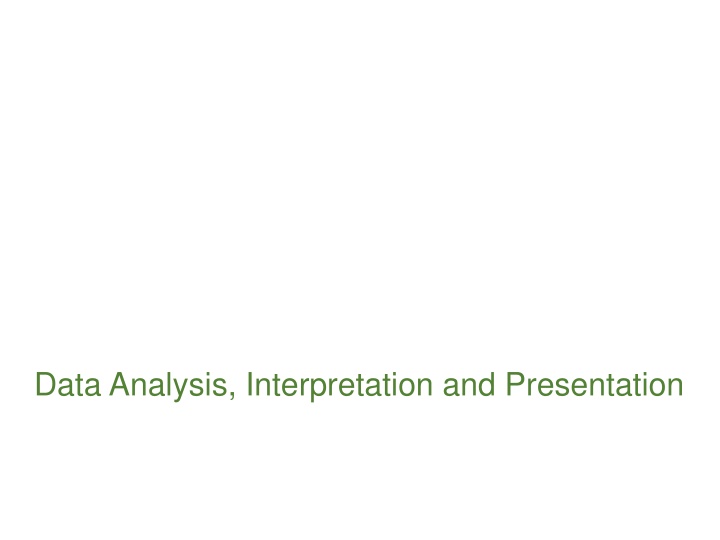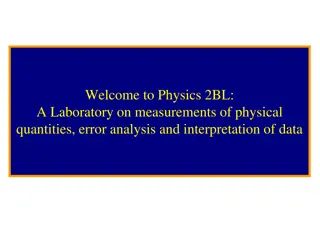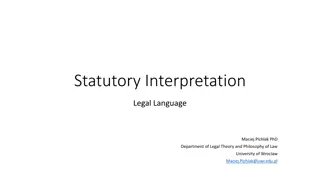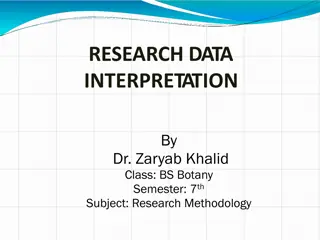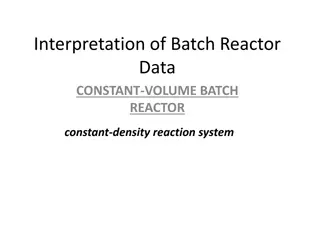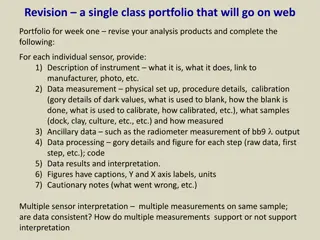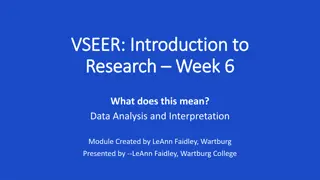Data Analysis, Interpretation and Presentation
This comprehensive guide explores the fundamental differences between quantitative and qualitative data analysis methods. It covers the interpretation of data from questionnaires, interviews, and observation studies, highlighting the importance of using appropriate software tools. Additionally, common pitfalls in data analysis, interpretation, and presentation are discussed, along with guidelines for interpreting and presenting findings effectively.
Download Presentation

Please find below an Image/Link to download the presentation.
The content on the website is provided AS IS for your information and personal use only. It may not be sold, licensed, or shared on other websites without obtaining consent from the author.If you encounter any issues during the download, it is possible that the publisher has removed the file from their server.
You are allowed to download the files provided on this website for personal or commercial use, subject to the condition that they are used lawfully. All files are the property of their respective owners.
The content on the website is provided AS IS for your information and personal use only. It may not be sold, licensed, or shared on other websites without obtaining consent from the author.
E N D
Presentation Transcript
Aims Discuss the difference between qualitative and quantitative data and analysis. Enable you to analyze data gathered from: Questionnaires. Interviews. Observation studies. Make you aware of software packages that are available to help your analysis. Identify common pitfalls in data analysis, interpretation, and presentation. Enable you to interpret and present your findings in appropriate ways. 2 www.id-book.com
Quantitative and qualitative Quantitative data expressed as numbers Qualitative data difficult to measure sensibly as numbers, e.g. count number of words to measure dissatisfaction Quantitative analysis numerical methods to ascertain size, magnitude, amount Qualitative analysis expresses the nature of elements and is represented as themes, patterns, stories Be careful how you manipulate data and numbers! www.id-book.com 3
Simple quantitative analysis Measures of Central Tendency Mean: add up values and divide by number of data points Median: middle value of data when ranked Mode: figure that appears most often in the data Measures of Variation Standard Deviation Range and Interquartile range 95% Confidence Interval Percentages Be careful not to mislead with numbers! Graphical representations give overview of data Number of errors made Number of errors made Internet use 10 Number of errors made 4.5 Number of errors made < once a day 4 8 3.5 3 once a day 6 2.5 4 2 once a week 1.5 2 1 2 or 3 times a week 0.5 0 0 0 5 10 15 20 1 3 5 7 9 11 13 15 17 once a month User User www.id-book.com 4
Visualizing log data Interaction profiles of players in online game www.id-book.com 5
Visualizing log data Log of web page activity www.id-book.com 6
Web analytics www.id-book.com 7
Simple qualitative analysis Recurring patterns or themes Emergent from data, dependent on observation framework if used Categorizingdata Categorization scheme may be emergent or pre-specified Looking for critical incidents Helps to focus in on key events www.id-book.com 8
Tools to support data analysis Spreadsheet simple to use, basic graphs Statistical packages, e.g. SPSS Qualitative data analysis tools Categorization and theme-based analysis Quantitative analysis of text-based data Nvivo and Atlas.ti support qualitative data analysis CAQDAS Networking Project, based at the University of Surrey (http://caqdas.soc.surrey.ac.uk/) www.id-book.com 9
Theoretical frameworks for qualitative analysis Basing data analysis around theoretical frameworks provides further insight Three such frameworks are: Grounded Theory Distributed Cognition Activity Theory www.id-book.com 10
Grounded Theory Aims to derive theory from systematic analysis of data Based on categorization approach (called here coding ) Three levels of coding Open: identify categories Axial: flesh out and link to subcategories Selective: form theoretical scheme Researchers are encouraged to draw on own theoretical backgrounds to inform analysis www.id-book.com 11
Code book used in grounded theory analysis www.id-book.com 12
Excerpt showing axial coding www.id-book.com 13
Distributed Cognition The people, environment & artefacts are regarded as one cognitive system Used for analyzing collaborative work Focuses on information propagation & transformation www.id-book.com 14
Activity Theory Explains human behaviour in terms of our practical activity in the world Provides a framework that focuses analysis around the concept of an activity and helps to identify tensions between the different elements of the system Two key models: one outlines what constitutes an activity ; one models the mediating role of artifacts www.id-book.com 15
Individual model 16 www.id-book.com
Engestrms (1999) activity system model 17 www.id-book.com
Presenting the findings Only make claims that your data can support The best way to present your findings depends on the audience, the purpose, and the data gathering and analysis undertaken Graphical representations (as discussed above) may be appropriate for presentation Other techniques are: Rigorous notations, e.g. UML Using stories, e.g. to create scenarios Summarizing the findings www.id-book.com 18
